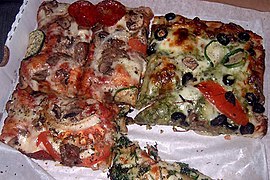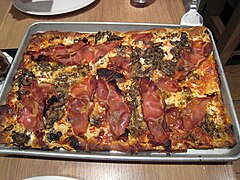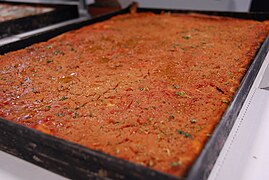
Pizza is a traditional Italian dish typically consisting of a flat base of leavened wheat-based dough topped with tomato, cheese, and other ingredients, baked at a high temperature, traditionally in a wood-fired oven.
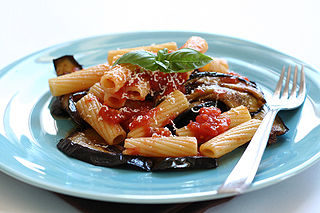
Sicilian cuisine is the style of cooking on the island of Sicily. It shows traces of all cultures that have existed on the island of Sicily over the last two millennia. Although its cuisine has much in common with Italian cuisine, Sicilian food also has Greek, Spanish, French, Jewish, and Arab influences.

Focaccia is a flat leavened oven-baked Italian bread. In some contemporary places, such as Rome, it is a style of pizza, also called pizza bianca. Focaccia may be served as a side dish or as sandwich bread and it may be round, rectangular, or square shape.

Calzone is an Italian oven-baked turnover, made with leavened dough. It originated in Naples in the 18th century. A typical calzone is made from salted bread dough, baked in an oven and stuffed with salami, ham or vegetables, mozzarella, ricotta and Parmesan or pecorino cheese, as well as an egg. Different regional variations in or on a calzone can often include other ingredients that are normally associated with pizza toppings. The term usually applies to an oven-baked turnover rather than a fried pastry, though calzoni and panzerotti are often mistaken for each other.
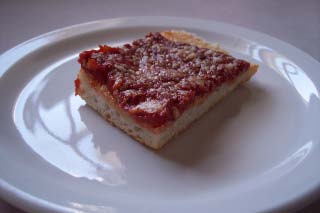
Italian tomato pie is an Italian-American and Italian-Canadian baked good consisting of a thick, porous, focaccia-like dough covered with tomato sauce. It may be sprinkled with Romano cheese or oregano. It is not usually served straight from the oven, but allowed to cool and then consumed at room temperature or reheated. Like Sicilian pizza, tomato pie is baked in a large rectangular pan and usually served in square slices, although in Rhode Island it is cut into rectangular strips like pizza al taglio. Tomato pie descends from and resembles the Italian sfincione, although it is not the same dish. For instance, sfincione may have toppings, is usually served hot, and has a crust more like brioche than focaccia.

Stromboli is a type of baked turnover filled with various Italian cheeses and usually Italian cold cuts or vegetables, served hot. The dough used is either Italian bread dough or pizza dough. Stromboli was invented by Italian Americans in the United States, in the Philadelphia area. The name of the dish is taken from a volcanic island off the coast of Sicily.

Italian-American cuisine is a style of Italian cuisine adapted throughout the United States. Italian-American food has been shaped throughout history by various waves of immigrants and their descendants, called Italian Americans.

White pizza is a style of pizza that does not use tomato sauce. The pizza generally consists of pizza dough, olive oil, garlic, cheese, salt and, sometimes, toppings including vegetables such as spinach, tomato and herbs. A béchamel sauce is sometimes used in place of tomato sauce, and sliced tomatoes may be added to top the pizza.
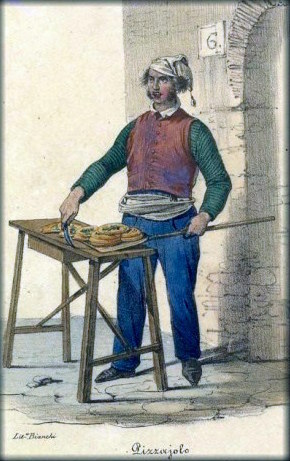
The history of pizza begins in antiquity, as various ancient cultures produced flatbreads with several toppings.
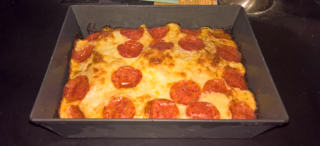
Detroit-style pizza is a rectangular pan pizza with a thick, crisp, chewy crust. It is traditionally topped to the edges with mozzarella or Wisconsin brick cheese, which caramelizes against the high-sided heavyweight rectangular pan. Detroit-style pizza was originally baked in rectangular steel trays designed for use as automotive drip pans or to hold small industrial parts in factories. It was developed during the mid-20th century in Detroit, Michigan, before spreading to other parts of the United States in the 2010s. It is one of Detroit's iconic local foods.

Uruguayan cuisine is a fusion of cuisines from several European countries, especially of Mediterranean foods from Spain, Italy, Portugal and France. Other influences on the cuisine resulted from immigration from countries such as Germany and Scotland. Uruguayan gastronomy is a result of immigration, rather than local Amerindian cuisine, because of late-19th and early 20th century immigration waves of, mostly, Italians. Spanish influences are abundant: desserts like churros, flan, ensaimadas yoo (Catalan sweet bread), and alfajores were all brought from Spain. There are also all kinds of stews known as guisos or estofados, arroces, and fabada. All of the guisos and traditional pucheros (stews) are also of Spanish origin. Uruguayan preparations of fish, such as dried salt cod (bacalao), calamari, and octopus, originate from the Basque and Galician regions, and also Portugal. Due to its strong Italian tradition, all of the famous Italian pasta dishes are present in Uruguay including ravioli, lasagne, tortellini, fettuccine, and the traditional gnocchi. Although the pasta can be served with many sauces, there is one special sauce that was created by Uruguayans. Caruso sauce is a pasta sauce made from double cream, meat, onions, ham and mushrooms. It is very popular with sorrentinos and agnolotti. Additionally, there is Germanic influence in Uruguayan cuisine as well, particularly in sweet dishes. The pastries known as bizcochos are Germanic in origin: croissants, known as medialunas, are the most popular of these, and can be found in two varieties: butter- and lard-based. Also German in origin are the Berlinese known as bolas de fraile, and the rolls called piononos. The facturas were re-christened with local names given the difficult German phonology, and usually Uruguayanized by the addition of a dulce de leche filling. Even dishes like chucrut (sauerkraut) have also made it into mainstream Uruguayan dishes.

Neapolitan cuisine has ancient historical roots that date back to the Greco-Roman period, which was enriched over the centuries by the influence of the different cultures that controlled Naples and its kingdoms, such as that of Aragon and France.
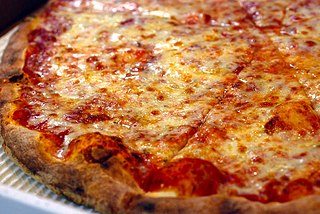
Pizza arrived in the United States in the early 20th century along with waves of Italian immigrants who settled primarily in the larger cities of the Northeast, such as New York, Philadelphia, Boston and Baltimore. After American soldiers stationed in Italy returned from World War II, pizza and pizzerias rapidly grew in popularity.
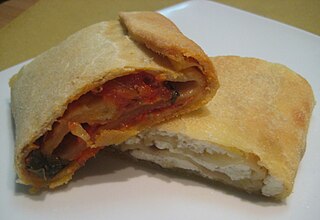
Scaccia, scacciata or schiacciata is a Sicilian stuffed flatbread. Scaccia is made with a very thin rectangular layer of dough, folded on itself three or four times. It can be stuffed with different ingredients, the more common variations are ricotta cheese and onion, cheese and tomato, tomato and onion, or tomato and eggplant, depending on location, taste, or season. It is baked and can be eaten hot or cold. Scacciata derives from the Sicilian word meaning to drive away, equivalent to the Italian word schiacciata, meaning 'to crush' or 'to flatten'. Scaccia can be found in Ragusa and Siracusa, as well as some Sicilian American communities.

The traditional cuisine of Abruzzo is eclectic, drawing on pastoral, mountain, and coastal cuisine. Staples of Abruzzo cuisine include bread, pasta, meat, fish, cheese, and wine. The isolation which has characterized the region for centuries has ensured the independence of its culinary tradition from those of nearby regions. Local cuisine was widely appreciated in a 2013 survey among foreign tourists.
Tomato pie may refer to a pie with tomatoes, such as:
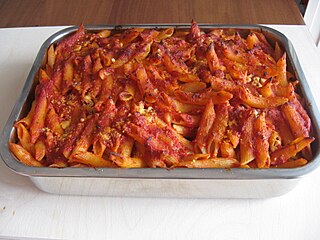
Pasta al forno or timballo di pasta is a typical dish of Italian cuisine, made of pasta covered with béchamel sauce, tomato sauce and cheese, and cooked in the oven.
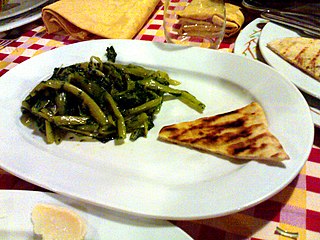
Crescia is a thin Italian flatbread typically prepared in Marche and Umbria. The crescia probably has a common ancestry to the piadina, to be found in the bread used by the Byzantine army, stationed for centuries in Romagna, in the north of the Marche (Pentapolis), and in the Umbrian Valley crossed by the Via Flaminia. The food is also known by the common name of "white pizza".


